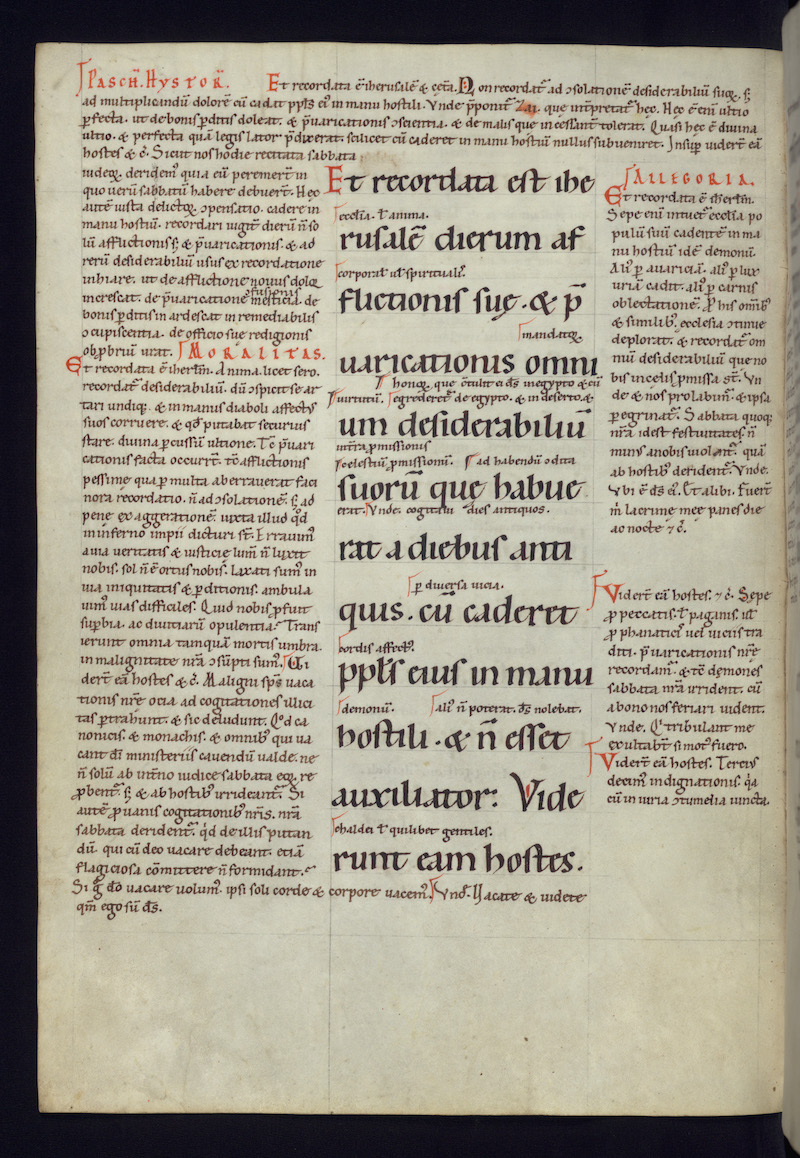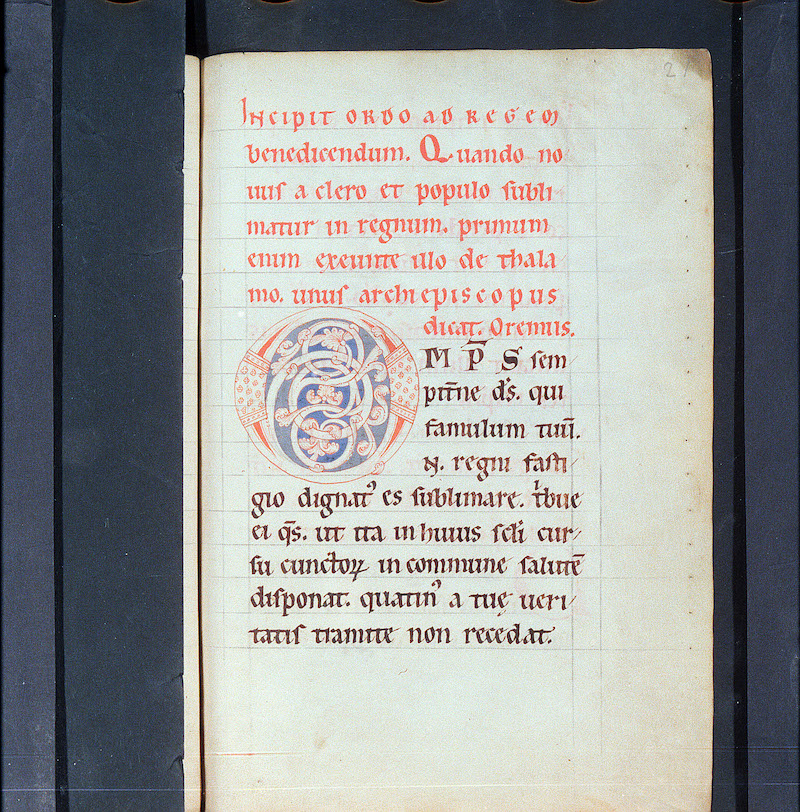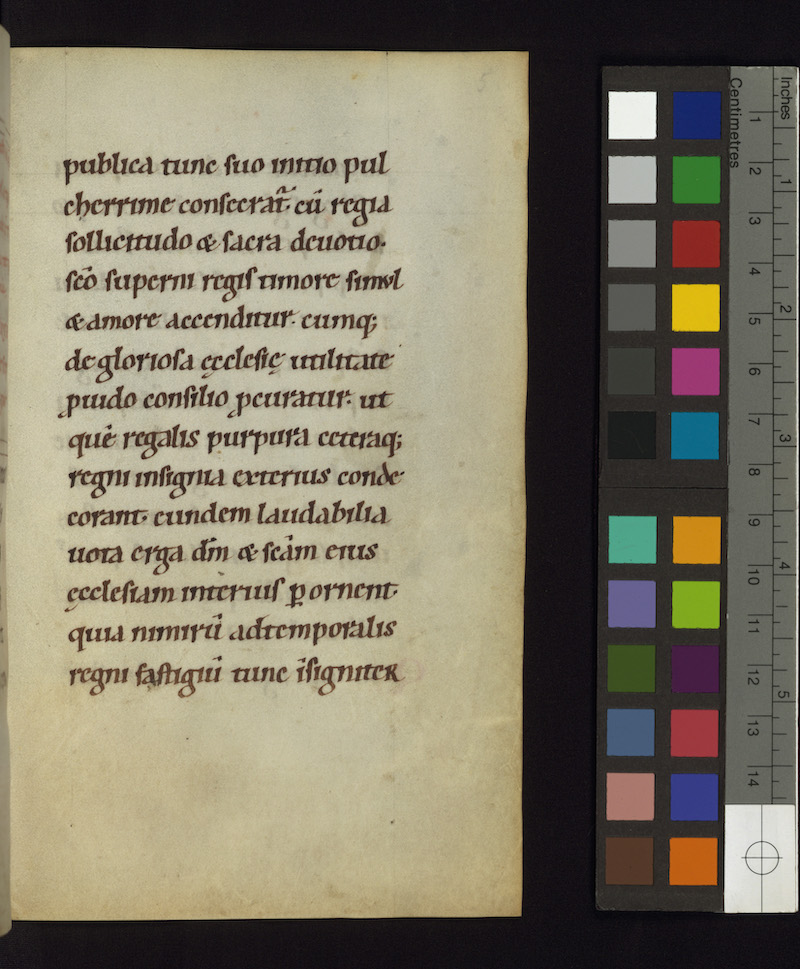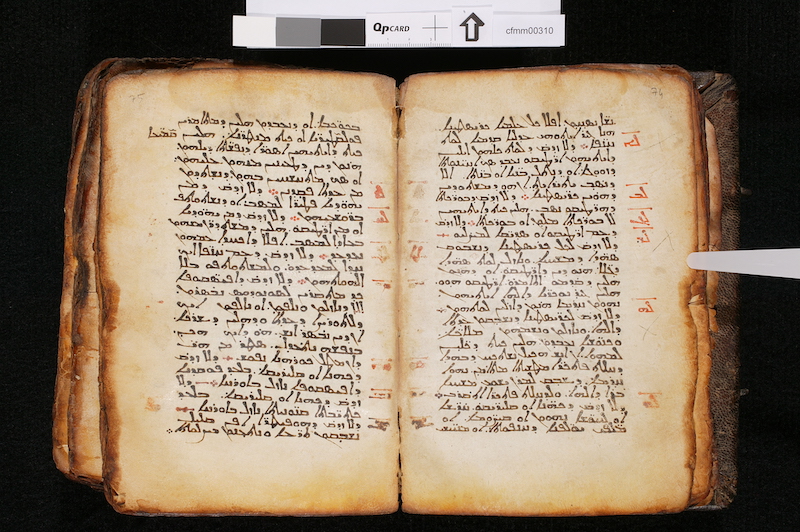
Protogothic, 12th century
-
Title
Bible. New Testament -
Text
Matthew 14:30-15:14 -
Language(s)
Latin -
Writing System
Roman -
Script(s)
Protogothic -
Country
Unitied States of America -
City
Baltimore -
Repository
Walters Art Museum -
Shelf Mark
W.18, fol. 11v -
Common Name
Rochester New Testament -
Century
12th century -
Year Range
1100-1150 -
Place Of Origin
England, Rochester Cathedral Priory -
Provenance
Purchased by Henry Walters from Leon Gruel in 1931 -
Bibliography
J. J. G. Alexander and C. M. Kauffmann, English Illuminated Manuscripts 700-1500 (1973).
T.S.R. Boase, English Art 1100-1216 (1959).
-
External Facsimile
The Rochester New Testament is one of two surviving volumes from an original five-volume set of the complete Bible. The other surviving volume is now London, British Library MS Royal I.C.VII. At approximately 11" x 15", it is a fairly large book – not as large as monumental books like the Lindisfarne Gospels, but substantially larger than books made for private study. The manuscript has many inhabited and foliate initials; see the full digitized manuscript at the Walters' website (link below) for high-resolution images.
This manuscript illustrates the transitional phase between Carolingian and Gothic script and layout. The script – a Protogothic minuscule – is at once typical of the 12th century in combining Caroline letterforms with Gothic proportions and aspect, and atypical in that it has characteristics peculiar to the Southeast of England – Rochester and/or Canterbury – in this period.
Letterforms that remain those of Caroline minuscule are, most notably, upright d; in many but not all places, tall s at the ends of words; and the ampersand (&) for et. Individual forms that reflect emergent features of Textualis are an h whose second stroke curves around and dips below the baseline; a diagonal tongue closing the bowl of e; consistent treatment of feet with upwards hairstrokes that follow the same diagonal; and forked serifs on ascenders.
This distinctive southern English version of the transitional Pregothic script has several letterforms that are diamond- or lozenge-shaped, especially a, c, d, e, and o. All these are letters with bows or curves on their left sides. In Caroline minuscule, and in most other Pregothic scripts, those bows would be actual curves, and the letters would be egg-shaped, rather than lozenge-shaped. (Compare the German Protogothic manuscripts elsewhere in this collection.) In Textualis, the leftmost side of the bows would be made with a vertical stroke. But here, the leftmost part of the bow is a point – the juncture of a thick slower stroke and a hairline upper stroke. The effect of this treatment of bows is to lend a slender and somewhat spiky aspect to the script. This English evolution of Caroline minuscule may owe something to the influence of vernacular minuscules.
More striking than the emergence of particular Gothic-style letter details is the overall impression of the writing the page: letters closely spaced, taller than they are wide, with a concomitant reduction of space between lines: all these give the impression of two long, dark, dense columns of text, which is a hallmark of Gothic book layout. Layout features that hark back to Carolingian book design are the placement of initials outside the block of text; the almost-invisible ruling (so that the ruled lines are not part of the decoration of the page); the fact that the writing starts above the first ruled line; and the fact that the feet of letters sit on the ruled line rather than floating above it. The green ink used for the large initial is also typical of 12th-century manuscripts, in contrast to those of both earlier and later periods.
Acknowledgements: Described by Carin Ruff
Transcription
Column 1
1 saluum me fac∙ Et continuo
2 ie(su)s extendens manum appre-
3 hendit eum∙ et ait illi∙ Modicȩ
4 fidei quare dubitasti? Et cu(m)
5 ascendissent in nauiculam∙´
6 cessauit uentus∙ Qui aute(m) in
7 nauicula erant∙´ uenerunt
8 et adorauerunt eu(m) dicentes∙
9 Vere dei filius es∙ Et cum trans-
10 fretassent∙´ uenerunt in terra(m)
11 genesar∙ Et cum cognouissent
12 eum uiri loci illius∙´ miser(un)t
13 in uniuersam regione(m) illam∙
14 Et obtulerunt ei omnes male
15 habentes∙ et rogabant eum
16 ut uel fimbriam uestimenti
17 eius tangerent∙ Et quicunq(ue)
18 tetigerunt∙´ salui facti sunt∙
19 Tunc accesserunt ad eum
20 ab ierosolimis scribȩ et phari-
21 sei dicentes∙ Quare discipuli
22 tui transgrediuntur traditi-
23 ones seniorum? Non enim
24 lauant manus suas∙ cum pa-
25 nem manducant∙ Ipse autem
26 respondens ait illis∙ Quare et
27 uos transgredimini mandatu(m)
28 dei p(ro)pter traditionem u(est)ram?
29 Nam d(eus) dixit∙ Honora patrem
30 et matrem∙ et q(ui) maledixerit
Column 2
1 patri uel matri∙ morte mori-
2 atur∙ Vos autem dicitis∙ q(ui)-
3 cunq(ue) dixerit patri uel ma-
4 tri munus q(uo)dcunq(ue) est ex
5 me tibi proderit∙ et non ho-
6 norificauit patrem suum
7 aut matrem∙ et irritum fe-
8 cistis mandatum dei p(ro)pter
9 traditionem u(est)ram∙ Hypo-
10 chritȩ bene p(ro)phetauit de
11 uobis isaias dicens∙ Populus
12 hic labiis me honorat∙ cor
13 autem eorum longe est a me∙
14 Sine causa aute(m) colunt me∙´
15 docentes doctrinas et man-
16 data hominum∙ Et conuo-
17 catis ad se turbis dixit eis∙
18 Audite et intelligite∙ Non
19 q(uo)d intrat in os coinquinat
20 hominem∙ sed quod p(ro)cedit
21 ex ore hoc coinquinat homi-
22 nem∙ Tunc accedentes disci-
23 puli eius dixerunt ei∙ Scis
24 quia pharisei audito hoc
25 uerbo scandalizati sunt?
26 At ipse respondens ait∙ Omnis
27 plantatio quam non planta-
28 uit pater m(eu)s cȩlestis∙ eradi-
29 cabitur∙ Sinite illos∙ cȩci s(un)t∙
30 duces cȩcorum∙ Cȩcus
Paleographic Features
1. "Round" letters are lozenge-shaped, with point at leftmost part of bow: a characteristic of this local variety of Pregothic. Note for example the e in me and the co in continuo, col. 1, line 1.
2. ascendissent in col. 1, line 4 shows the strongly diagonal hairstrokes at the feet of most letters, echoing the diagonal tongue of e: features of Protogothic script as it develops into Textualis.
3. Forked ascenders, a feature of Protogothic script as it develops into Textualis, are seen for example on the d in ascendissent and the l in nauiculam, in col. 1, line 4.
4. In col. 1, line 9, note that the littera notabilior is in the ruled marginal space, outside the main written area. This is a Carolingian feature.
5. The scribe uses both tall s (Caroline) and round s (Gothic) at word end, as for example in filius es, col. 1, line 9.
6. Green ink, as in the large T in the left margin, is a Romanesque (12th-century) feature.
7. Three lines from the bottom of col. 1, the last symbol on the line is a question mark. We have transcribed it with the modern question mark in the transcription. You can find other examples on the page.
8. The second stroke of h curving around and down, as in the first letter of col. 2, line 12, is a Gothic symptom.
9. In labiis, the second word in col. 2, line 12, the scribe puts strokes over ii to distinguish them from other sequences of minims (like n or u). Stroking a pair of is is a 12th-century innovation in response to the emerging Gothic aesthetic of closely-spaced parallel minims. (A stroke over one i in isolation does not appear until the 13th century and becomes common in the 14th.)



